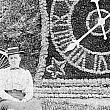Charles Garfield and the Playground Movement
by Rebecca Smith-Hoffman
In 1908, the Grand Rapids Board of Trade sponsored the “Grand Rapids Civic Revival” featuring civic revivalist Charles Zueblin. Zueblin spoke twice a day for seven days to interested citizens on such topics as the making of the city, transportation, parks and recreation, and the administration of a city. Among the numerous committees formed was the More Beautiful City Committee dedicated to the esthetic improvement of Grand Rapids. From this committee grew the Playground Association of Grand Rapids, organized early in 1910 with Charles Garfield as its president. With the motto “A playground for every child, within one-half mile of its home,” the association successfully campaigned for passage of a $200,000 bond issue that same year to fund the purchase of land for playgrounds. The following year the association successfully lobbied for city funding of supervised programs at the playgrounds.
Under the direction of Charles Garfield, Grand Rapids became a leader in the national playground movement, which encouraged playground development and supervised play as a weapon in the fight against juvenile delinquency and as a means to improve the physical and mental health of children.
In 1912, Charles H. Mills came to Grand Rapids from Hull House in Chicago to develop and to oversee the playground programs. Under Mills’ direction each city park and playground, including John Ball Park, offered children supervised activities from 10:00 a.m. until 5:00 p.m. six days a week during the summer months. Park acreage throughout the city increased from 140 acres in 1907 to nearly 1,300 acres in 1929. Between 1912 and the depression years of 1933-34, Grand Rapids developed one of the finest recreation programs in the country. Each year all program participants gathered at John Ball Park in August for a field day to end the summer season. The swimming pool once located at the south end of John Ball Park was constructed during this period (1915) and closed in 1934 when it could no longer be maintained.
An interesting historical footnote illustrates the strong influence of the Dutch Calvinists and other religious conservatives in Grand Rapids during the early half of the twentieth century. A city ordinance required that the playgrounds be closed on Sundays. In 1915, the Grand Rapids Press reported that Rev. J. A. Schmitt, rector of St. Mary’s Catholic Church, and Playground Association president, Charles Garfield met with the city’s Morals Efficiency Commission to request that city playgrounds be allowed to open on Sunday afternoons for the families of workingmen. Father Schmitt argued that harmless physical recreation was a benefit. Mr. Garfield called attention to the changing views of Sunday observance. Although there were no organized activities, the playgrounds were allowed to open on Sundays.
During the early years of the Depression, the Board of Education assumed operation of the playground program because Federal Emergency Relief Administration (FERA) funds were available only to educational agencies. This federal aid allowed the board to run the recreation programs and to maintain the parks and playgrounds. Playground directors were recruited from Works Progress Administration rolls. In 1934, the John Ball Park bandshell was constructed with FERA funding, which also paid the salaries of the musicians that made up a concert band and a symphony orchestra. On Thursday evenings free concerts were offered in the park by the orchestra and on Sunday afternoons by the band.

 facebook
facebook


